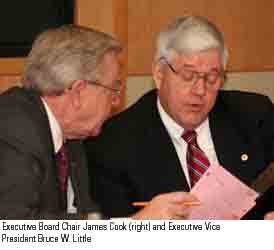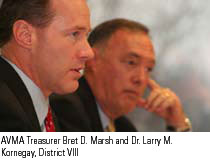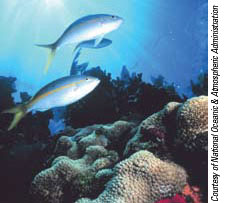More news from the boardroom
The recommendations before the AVMA Executive Board this past November 16-18 dealt with a broad range of subjects. The following report concludes the coverage that began in the Jan. 1 issue.

In November, each of more than 120 recommendations was reviewed by one of three reference committees before going to the board. Each Executive Board member serves on one of the reference committees: A—Budget and Financial Review, B—Council Recommendations Review, or C—Administrative, Board, and Committee Recommendation Review.
A reference committee can recommend that the board approve, disapprove, or refer an agenda item; take no action; or approve it on the consent agenda. The consent agenda comprises recommendations that the reference committees viewed favorably and considered uncontroversial. At any time during the board meeting, however, a member can have an item removed from the consent agenda and addressed individually. As the last order of board business, the chair calls for a single vote on the consent agenda. In November, 65 recommendations were approved by this efficient process.
Treasurer's report
During his report to the Executive Board, AVMA Treasurer Bret D. Marsh said that as of Oct. 31, 2006, the Association was nearly $1 million ahead on its earnings on investments —more than 100 percent over budget.
This positive news will offset a 2006 convention shortfall. Although the Hawaii convention set an attendance record and overall satisfaction was higher than ever, the treasurer said, revenues weren't as high as expected and expenses were higher.

"Because of some of the idiosyncrasies of this year's convention, it will not be in the black," Dr. Marsh told the board. "But I want to assure the board that overall, this year we will be in the black."
He attributed the convention deficit to factors such as "exorbitant fuel costs" that led to higher travel expenses than budgeted for, high food costs, and fewer exhibitors than expected.
National Veterinary Medical Service Act
The board approved support of a two-phase approach for implementing the National Veterinary Medical Service Act loan repayment program.
Passed by Congress in December 2003, the NVMSA authorizes the Agriculture Secretary to establish a loan repayment program for veterinarians who agree to serve in veterinary shortage areas and emergency situations.
In fiscal year 2006, Congress appropriated $500,000 to establish a pilot program. Recently, the $500,000 was placed in the USDA budget. The Department of Agriculture is formulating the rules, and the AVMA Governmental Relations Division submitted program recommendations developed by an advisory group it had assembled.
The two-phase approach that the AVMA Executive Board supports will be implemented by the USDA Cooperative State Research, Education, and Extension Service, in consultation with other USDA agencies and the AVMA GRD.
In phase one, an existing loan repayment program for federal employees will be used. During that time, existing studies such as the Food Supply Veterinary Medicine Coalition Report will be reviewed, and further studies will be funded to support promulgation of regulations needed to manage the full student loan repayment program.
Phase two includes promulgation of the regulations needed to fully implement the loan repayment program for areas where the Agriculture Secretary determines there are veterinary shortages. These would include urban and rural areas; practice sectors such as public health, epidemiology, and food safety; and federal government work.
The AVMA continues to work with members of Congress to obtain full funding for the program in FY 2007 and beyond.
Pet foods: calorie content; therapeutic claims
 The Executive Board approved support for a proposed amendment from the American College of Veterinary Nutrition asking the Association of American Feed Control Officials to make calorie content statements mandatory on all dog and cat food labels in its Model Pet Food Regulation PF9.
The Executive Board approved support for a proposed amendment from the American College of Veterinary Nutrition asking the Association of American Feed Control Officials to make calorie content statements mandatory on all dog and cat food labels in its Model Pet Food Regulation PF9.
The AVMA Council on Veterinary Service recommended AVMA support because it believes that more accurate nutritional labeling is needed on pet food products so that veterinarians can make informed recommendations to their clients.
The council learned of the ACVN proposal when it began looking into concerns over inadequate pet food labeling. The ACVN presented its proposed amendment to the AAFCO Pet Food Committee in June 2005. The amendment would also require that the statement be expressed as kilocalories of metabolizable energy per kg and as kcal ME per familiar household measure or other discrete unit, such as cans, cups, or biscuits. The label would have to expressly and clearly differentiate whether the calorie content label information was determined by chemical analysis and calculation or by animal feeding.
Although AAFCO tabled discussion of the ACVN amendment twice in 2006, it may resume discussion this month. The Pet Food Institute is actively opposing the amendment and submitted a counterproposal.
In a separate recommendation, the AVMA Executive Board approved a policy on Pet Food Therapeutic Claims. It resulted from two AVMA entities exploring the regulation and oversight of therapeutic pet foods.
Over the past year, the Council on Biologic and Therapeutic Agents and the Clinical Practitioners Advisory Committee invited representatives from the Food and Drug Administration's Center for Veterinary Medicine and the pet food industry to AVMA headquarters to confer with them on this issue.
The council determined that the Food, Drug, and Cosmetic Act considers products intended for use in the diagnosis, cure, mitigation, treatment, or prevention of disease in humans or other animals to be drugs. However, the FDA has used regulatory discretion and allowed commercial products intended to provide both nutrition and disease treatment to be regulated as food, provided they meet criteria such as be marketed only through a licensed veterinarian.
The AVMA policy on Pet Food Therapeutic Claims, states the following:
Pet Food Therapeutic Claims
The regulatory oversight of wellness and therapeutic pet foods falls under the jurisdiction of the Food and Drug Administration (FDA). The FDA utilizes a significant degree of "regulatory discretion" in the oversight of all forms of pet food manufactured, marketed and sold within the United States. In most instances the FDA has relinquished the responsibility of evaluating therapeutic claims of product efficacy to the veterinary community.
Quality pet food products with valid efficacy data do exist. However, there is a wide discrepancy in the quality of products and validity of marketing and advertising claims within the pet food industry.
It is incumbent upon veterinarians to critically assess all product labels, advertising, and promotional materials utilizing principles of evidence based medicine prior to utilization or recommendation of any wellness or therapeutic pet food.
The AVMA encourages the pet food industry to act responsibly in making claims of therapeutic efficacy supported by quality scientific evidence.
Accreditation standards
The board established a six-member task force to conduct a comprehensive review of the standards for accreditation of veterinary schools and colleges.
The Council on Education believes the demand to stress outcomes is growing, while the emphasis on educational resources has lessened. The review of accreditation standards will respond to changing educational needs, recognition requirements of the U.S. Department of Education and the Council on Higher Education Accreditation, and societal demands for veterinarians and veterinary services.
The task force comprises three members of the Council on Education—Dr. James J. Brace, Dr. René Carlson, and Anne A. Payne—along with three members of the Association of American Veterinary Medical Colleges—Drs. Daryl Buss, Bennie Osborne, and Joan Hendricks. The task force will meet three times, with the AVMA spending $7,500 toward meals and travel expenses.
Ownership of wild animals
The board approved a broad policy on Private Ownership of Wild Animals to replace a policy on Wild Animals as Pets, which emphasized the hazards of keeping wild carnivores or dangerous reptiles and amphibians as pets. The new policy states, in part:
The AVMA recommends limiting or prohibiting private ownership of indigenous and non-native wild animals that pose a significant risk to public health, domestic animal health, or the ecosystem, as well as those species whose welfare is unacceptably compromised.
The Council on Public Health and Regulatory Veterinary Medicine drafted the policy with input from the Animal Welfare Committee and Committee on Environmental Issues.
At its spring 2006 meeting, the Executive Board tabled the council's proposed policy that simply said: "The American Veterinary Medical Association opposes keeping wild animals as pets." The Animal Welfare Committee suggested that the policy should be somewhat less broad (see JAVMA, May 15, 2006).
The Animal Welfare Committee supports the new policy. The committee is considering developing a separate policy on ownership of wild animals from the perspective of animal welfare rather than public health.
Aquatic ecosystems
The board approved a policy on Aquatic Ecosystems to guide veterinarians in addressing the negative impacts of human activities on freshwater, estuarine, and marine aquatic ecosystems.

The policy states, in part:
The AVMA recognizes the pressing need for effective actions, based on sound science and coordinated among all relevant stakeholders, to ensure the future health of aquatic animals and the ecosystems that support them. The AVMA believes that veterinarians, with their education and experience in the application of science in the field of integrated health management, can and should play a pivotal role in addressing this need.
The recommended actions are grouped under the three general areas of sustainable harvest and conservation of aquatic animal resources; targeted education for veterinary professionals; and coordination of legislation, regulations, and policies—with the input of relevant stakeholders—to ensure the health of aquatic animals and the aquatic environment.
Protecting animals in research
On a recommendation from the Council on Research, the board approved a policy opposing the Use of Placebo Controls in Assessment of New Therapies for Alleviation of Acute Pain in Client-Owned Animals. The policy states, in part, that "the availability of, and clinical experience with, a number of existing effective, and in most cases FDA-approved, pain-relieving compounds currently in use today in veterinary practice significantly diminishes the rationale and justification for including such placebo control groups in prospective studies on acute pain."
This past year, the AVMA sent a letter encouraging the Food and Drug Administration's Center for Veterinary Medicine to prohibit placebo control studies for assessment or approval of new pain-control medications when FDA-approved pain management products are available (see JAVMA, Jan. 15, 2005).
Poultry depopulation
The board approved a policy on the Use of Water-Based Foam for Depopulation of Poultry under specific disease conditions or in disaster situations. The AVMA, particularly its Animal Welfare Committee and Animal Welfare Division, has worked with the Department of Agriculture to help develop criteria for the appropriate use of firefighting foam for mass depopulation of poultry.
The policy states that the AVMA supports the use of foam to depopulate poultry, in accord with conditions and performance standards established by the USDA Animal and Plant Health Inspection Service, in the following scenarios:
- Animals are infected with a potentially zoonotic disease
- Animals are experiencing an outbreak of a rapidly spreading infectious disease that, in the opinion of state or federal regulatory officials, cannot be contained by conventional or currently accepted means of depopulation
- Animals are housed in structurally unsound buildings that would be hazardous for human entry, such as those that may result from a natural disaster
The policy differentiates between depopulation, which kills animals efficiently and quickly under extenuating circumstances, and euthanasia, which makes death as painless and stress-free as possible. The AVMA currently considers destruction of poultry using water-based foam to be a method of mass depopulation and not a form of euthanasia. The AVMA supports research to evaluate foam as a form of euthanasia.
Clinical Proficiency Examination
The board approved allowing individual veterinarians to sit for the Clinical Proficiency Examination at the request of state or provincial licensing agencies.
The hands-on examination is the final step in the certification program through the Educational Commission for Foreign Veterinary Graduates. In the past, high demand for examination positions by candidates for certification prevented the ECFVG from allowing graduates of AVMA-accredited colleges to take the test. With the addition of two testing sites in 2005, the number of examination positions meets the demand.
The board revised the ECFVG description to include an objective "to allow utilization of ECFVG examinations and other assessment resources to evaluate the professional competence of graduates of AVMA/Council on Education-accredited colleges of veterinary medicine when such utilization is to the benefit of the state and provincial veterinary licensing agencies, and other concerned parties."
This action means that state regulatory boards can use the CPE as part of the disciplinary process for licensed veterinarians whose competence is called into question. The Canadian National Examining Board can now request veterinarians who twice fail the North American Veterinary Licensing Examination to sit for the CPE.
National veterinary museum
The board disapproved forming a task force to study possibilities for a national veterinary museum. A number of museums and exhibits across the country endeavor to preserve the history of the profession. From 1976-1986, the AVMA maintained an exhibit on contemporary veterinary medicine at Chicago's Museum of Science and Industry.
As its sesquicentennial approaches in 2013, the AVMA has been exploring the possibility of a traveling exhibit on a subject close to veterinary medicine with the Smithsonian Institution Traveling Exhibition Service. As envisioned, museums across the country would host the traveling exhibit over the course of several years.
Appointments
One liaison and five committee appointments were made by the board. Dr. Lorraine Jarboe, Fort Walton Beach, Fla., will fill an unexpired term on the AVMA Clinical Practitioners Advisory Committee representing the American Association of Feline Practitioners. Drs. Stephanie Ostrowski, Whitesburg, Ga., and Terry Kane, Cincinnati, will complete unexpired terms on the AVMA Committee on Disaster and Emergency Issues. Dr. Ostrowski will represent the Uniformed Services and Dr. Kane the AVMA Veterinary Medical Assistance Teams. Dr. Stacy Pritt, Denver, Pa., will complete an unexpired term on the AVMA Legislative Advisory Committee representing the American Society of Laboratory Animal Practitioners, and Dr. Mary Kennett, State College, Pa., will serve as the alternate.
Dr. Ching Ching Wu, West Lafayette, Ind., was appointed representative in a new liaison from the AVMA to the Codex Ad Hoc Intergovernmental Task Force on Antimicrobial Resistance.
Other noteworthy actions
The board approved policies or policy changes that accomplished the following:
- emphasized the urgent need for an efficacious vaccine for canine influenza
- added the categories of Biodefense against Bioterrorism, and Comparative and Laboratory Animal Medicine to the research priorities of the AVMA and the Association of American Veterinary Medical Colleges
- updated the Guidelines for Veterinary Practice Facilities—with updates including guidance that a practice should maintain restraint facilities that are humane in providing proper care to patients during all aspects of a visit, proper equipment for anesthesia management, and an aseptic surgical environment with appropriate pre- and post-operative considerations
- changed the Guidelines on Emergency Veterinary Service to include a point that "When veterinarians cannot be available to provide services, they should pre-arrange with their colleagues to assure that timely and adequate emergency services are available, consistent with the needs of the locality"
- recognized as a resource the new Model Infection Control Plan for Veterinary Practices from the Veterinary Infection Control Committee of the National Association of State Public Health Veterinarians
- encouraged that any future FDA prohibitions on the extralabel use of drugs in food-producing animals be limited rather than broad, consistent with the protection of the food supply, public health, and animal welfare
- encouraged the FDA to consider amending the agency's rules or Compliancy Policy Guide on Extra label Use of Medicated Feeds for Minor Species to accommodate the extra label use of veterinary feed directive drugs in minor species
- supported sufficient operational funding for organizations that make up the National Centers for Animal Health to reflect a rise in operational costs resulting from modernization
- replaced separate guidelines on judicious therapeutic use of antimicrobials in cats and in dogs with a joint document from the American Association of Feline Practitioners and the American Animal Hospital Association
- broadened the policy on Pesticide Application to state that veterinarians should remain exempt from certification to apply any pesticide, even as the Environmental Protection Agency considers expanding regulations
- altered one of the objectives of the Committee on Environmental Issues, which will now "raise awareness of environmental issues throughout veterinary medical careers/disciplines" rather than "raise awareness about environmental career opportunities in veterinary medicine," and reduced the frequency of committee meetings from twice a year to once a year
- created a third position in the Department of State Legislative and Regulatory Affairs, within the AVMA Communications Division, to help respond to the rising numbers of requests from constituent organizations for research and legislative assistance
- created another position for an assistant director in the Scientific Activities Division to help handle a workload that has grown with the increasing influence of the AVMA on science-based policy decisions
- delayed from 2006 to 2007 an AVMA study of the use of technology by veterinarians and a follow-up to the AVMA Public Perceptions Survey, as staff continues to review data from previous research
AVMA policies are online at www.avma.org; click on Policy under Issues